
We continue to see the appearance of the F1 generation adult this week in very low numbers. However, in our caged studies on BMSB development we have had very low levels of emergence with no observations of mating or egg laying. The onset of 2nd generation egg laying and nymph development will likely begin by mid-August or earlier. At this point in time scouting of the orchard perimeter along wooded edge of deciduous trees should begin and should be coupled with the use of pheromone traps to determine the presence and number of BMSB in blocks of pome and stone fruit.

We continue to recommend that growers purchase and utilize BMSB Tedders traps this season, especially as we move into the development of the 2nd generation in late July. Coupled with scouting, trap placement along your orchards, bordering deciduous woodlands using duel #10 and MDT pheromone blend, will provide an important component in monitoring for this invasive and damaging pest on your farm. Populations are quite variable throughout the Hudson Valley with orchard BMSB captures ranging from single weekly captures to over 30 per week to date. AgBio Link to purchase traps and lures
Data from the mid-Atlantic states (USDA-ARS WV) suggest the use of weekly trap captures above 40/week as a threshold for the beginning of BMSB management in locations where traps are used. Utilizing this threshold value, we are well below the numbers needed to begin management of BMSB in all but Milton-East traps.
If you are trapping along the orchard edge, and not seeing BMSB in the orchard BUT are seeing them in traps, we would recommend NOT SPRAYING. Trap captures should be used to initiate intensive monitoring of the crop, spraying only on first find of BMSB in the crop.
If you are finding adults in the trees, we would recommend management with border sprays at first adult edge find. Whole orchard applications should be made with the first nymph find as this event signifies an established population within the orchard.
Growers should consider spraying Alternate Row Middle (ARM) after the 1st of August if adults are scouted in the orchard, making whole orchard applications once nymphs are found. Continued scouting through to harvest is recommended.

The list of the most effective insecticides for BMSB management is found using this link. NYS labeled insecticides effective for use against the BMSB are available in four major classes including pre-mix formulations. Bifenthrin received an emergency exemption use permit (Section 18) to control brown marmorated stink bug (BMSB) on apples, peaches, and nectarines in Orange, Dutchess and Ulster Counties of NY. Products include Bifenthure and Brigade, showing the greatest degree of efficacy of the pyrethroid group.
Generally, stink bug are a dry weather insect pest, looking for water and nutrients in well irrigated agricultural systems after primary deciduous tree and weed hosts dry out. As we continue through the season we are likely to see increased movement of the pest to orchards, especially if we begin to experience drought conditions. The embedded image link to the EDDSMapS below will provide trapping data and levels of tree fruit damage by county as the season progresses.
This weeks weather forecast predicts warm temperatures in the mid-80’s with cool night time temps. 

